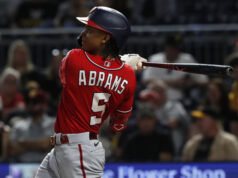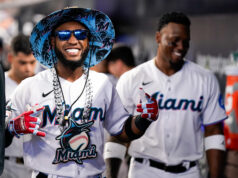With the demand for elite talent at an all time high teams are willing to overspend to get what they want even if financially it does not make the most sense.
By Aniello Piro
 With baseball’s offseason in full effect we have seen two big-name pitchers fall off the board with a third looming before the winter meetings.
With baseball’s offseason in full effect we have seen two big-name pitchers fall off the board with a third looming before the winter meetings.
The blueprint for championships has been built on good pitching and timely hitting. With several big-market teams looking for championships, the feeling is that acquiring top-tier talent in both categories is the answer.
But, what if I told you that signing all-star talent to lucrative contracts is one of the worst ways to earn a championship?
Look at the past five World Series Championship ball clubs and their pitching staffs.
Players like Johnny Cueto, Madison Bumgarner, Jon Lester, Adam Wainwright, and Matt Cain are names that have led teams to World Series championships.
The common denominator that these pitchers share is that they were either homegrown or acquired via trade.
None were brought in by way of “monstrous” contracts.
As a matter of fact, the last team that “bought” their way to a World Series championship was the 2009 New York Yankees.
Since then, teams have abandoned that way of thinking, and have looked in other avenues to acquire quality pitching, either by trade or through their farm system.
Many organizations are trapped in this delusion that in order to win big, you have to spend big. That’s an old wive’s tale.
Look at some of the more lucrative contracts players have signed in recent memory.
Justin Verlander (seven years/ $180 million), Felix Hernandez (seven years/ $175 million), Masahiro Tanaka (seven years/ $155 million), and Johan Santana (six years/ $137 million) just to name a few.
What do all of these pitchers have in common? Zero championships.
This does not apply to just pitchers, but position players as well.
Miguel Cabrera (eight years/ $248 million), Robinson Cano (10 years/ $240 million), and Prince Fielder (nine years/ $214 million).
All are some of the highest payed professional athletes today, yet no championship rings.
So why are organizations willing to give millions of dollars to players, when the numbers are against them?
Look at the New York Mets starting rotation.
Matt Harvey, Jacob deGrom, Noah Syndergaard, Zack Wheeler, and Steven Matz were all grown through the team’s farm system either through a trade or in the Major League Baseball draft.
According to the twitter account Jared Diamond of The Wall Street Journal, they made less than $2.5 million dollars combined in 2015.
Harvey,deGrom,Wheeler,Syndergaard,Matz,Niese,Colon,Familia,Torres, Robles,Gilmartin,Parnell,Gee,Edgin,Blevins made $34.5MM TOTAL in 2015.
— Jared Diamond (@jareddiamond) December 2, 2015
The Mets currently possess five starting pitchers that on the open market could be worth $1 billion. They made less than $2.5 million in 2015. — Jared Diamond (@jareddiamond) December 1, 2015
Even though the Mets did not win it all, their starting pitchers are all under the age of 27, and have the potential to win a World Series championship for a fraction of the cost.
Look at the St. Louis Cardinals starting rotation in their championship run of 2011: Chris Carpenter ($14 million), Jamie Garcia ($437k), Kyle Lohse ($12 million), Jake Westbrook ($8 million), Edwin Jackson ($8 million-payed by the Chicago White Sox).
Their World Series championship cost them a total of $42,437,000 dollars to their pitching staff alone. The 2015 Pirates spent a total of $27,262,000 on their starting rotation in 2015.
David Price is making more than that in one year. Unbelievable.
So what exactly is the problem with these long-term expensive contracts? Everything to be honest. They don’t make sense financially, unless you were to sign the player at a young age, for instance Giancarlo Stanton. Even then, people are still left scratching their heads.
Lets break down the Price’s contract, which he signed with the Boston Red Sox for seven years, worth $217 million. That comes out to around $31 million per year.
BREAKING: David Price agrees to deal with Red Sox on a 7-year, $217 million contract. (via @BostonGlobe) pic.twitter.com/yO8niRyhHY
— SportsCenter (@SportsCenter) December 1, 2015
David Price’s monster contract will pay him about $9K per pitch. ? https://t.co/s50gL1d58a pic.twitter.com/PrZh29WGQE — theScore (@theScore) December 2, 2015
Normally around the age of 33 or 34, a pitcher’s performance starts to decline. With Price being 30-years-old, the Boston Red Sox would be paying between $93-$124 million dollars at age 33, and beyond.
Yikes.
This could result in a similar situation the Yankees are in now with CC Sabathia, and we know how that is going.
The biggest issue with the long term big money contracts is the age at which the player signs the contract.
When Alex Rodriguez signed his lucrative contact with the Texas Rangers, he was 26-years-old entering his prime years. The expensive contract made sense because Rodriguez would have been 35-years-old when it expired.
Rodriquez was at an a age that he could play through the entirety of his contract at a high level on the field. But, he signed a second contract at the age of 33, where he was nearing the end of his prime.
The bottom line is players are signing long, expensive contracts in the prime of their careers. The organization that is able to sign them will still get some good and bad years on the diamond, before their contracts expire.
If you want to build a championship team, numbers show that you have to work from the ground up. It’s a process no doubt about it, but it is the right way to build a championship team as we have seen in the last five years.
Not only does building from the ground up provide wins, but it also provide financial stability for years to come.
[su_button url=”https://elitesportsny.com/2015/12/02/31951/” background=”#000080″ size=”10″ wide=”yes” center=”yes” radius=”0″]NEXT: Yankees Made Right Move Avoiding David Price’s High ‘Price-Tag’[/su_button]












